
I’ve posted and linked to this Article from The Atlantic Monthly before. First published in November 1960 it is now behind a paywall so readers are required to pay to read it on line. Well, sort of, but more on that in a minute. First here is a short excerpt from the article.
Unlike what happens to other great battles, the passing of the years and the retelling of the story have softened the horror of Omaha Beach on D Day.
This fluke of history is doubly ironic since no other decisive battle has ever been so thoroughly reported for the official record. While the troops were still fighting in Normandy, what had happened to each unit in the landing had become known through the eyewitness testimony of all survivors. It was this research by the field historians which first determined where each company had hit the beach and by what route it had moved inland. Owing to the fact that every unit save one had been mislanded, it took this work to show the troops where they had fought.
Here is a link to a PDF version of the original printed on paper article. Please read it in it’s entirety while it’s still on line.
Among the soldiers landing on Omaha Beach that day were Thirty-four young men from Company A, 116th Infantry Regiment, 29th Infantry Division. By the end of the day Nineteen of them would be dead. Four more would die in the following days. Bedford, VA proportionally suffered more losses than any other town in the United States.
Which is why the National D-Day Memorial is located in Bedford. It is well worth the drive out into the countryside to visit.
The generation that waged that war to destroy enemies of civilized society is quickly fading from the scene. Those of us who are from a younger generation bear the responsibility of keeping the memory of their lives and heroism alive.
Today I’ll be ensconced in my aptly named “Lazy Boy” recliner watching “The Longest Day.” Time permitting I’ll watch episode two of “Band of Brothers” which is “Day of Days.” From which I borrowed the title of this post.